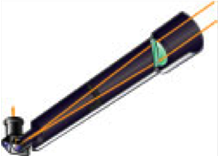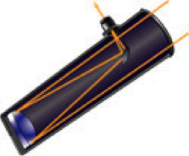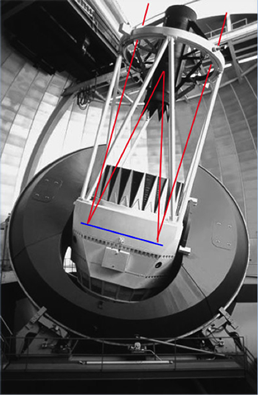-
WHAT IS NASA PHYSICS?
-
MODULES
-
Forces and Motion
-
Conservation of Momentum & Energy
-
Temperature and Heat
-
Fluids
-
Optics
-
Electromagnetic Spectrum
-
Modern Physics
-
Anticipation Guide 7
-
Intro to Modern Physics
-
Blackbody Radiation
-
The Ultraviolet Catastrophe
-
The Photoelectric Effect
-
Bohr's Atom
-
Spectra
-
Radioactive Decay
-
Special Relativity (SR)
-
Simultaneity
-
Distance and Time
-
General Relativity
-
May the Forces be with You
-
Modern Physics Notebook
-
Assessment Problems 7
-
-
Useful Things
-
-
SITE MAP
Optics
Telescopes
 Seeing the rings of Saturn, the moon of Jupiter, and craters of our Moon through your own backyard telescope is unforgettable. Image from Orion Telescopes.Telescopes do two things – they magnify the apparent size of objects so that more detail is visible, and they collect and concentrate light, allowing detection of very faint objects. Many different telescopes for personal use are available for prices starting at $100.
Seeing the rings of Saturn, the moon of Jupiter, and craters of our Moon through your own backyard telescope is unforgettable. Image from Orion Telescopes.Telescopes do two things – they magnify the apparent size of objects so that more detail is visible, and they collect and concentrate light, allowing detection of very faint objects. Many different telescopes for personal use are available for prices starting at $100.
Telescopes come in three general flavors: reflectors, retractors, and compound. Each type bends light to a fine focus.
Reflectors bend light by bouncing it off of a curved mirror called the primary at the bottom of a tube. The converging light reflected off this mirror is intercepted by a small diagonal mirror near the top of the tube that directs the focus outside the tube - otherwise the observer’s head would block the light. An eyepiece or a small digital camera records the view. The primary and the diagonal mirrors are precision ground to within a fraction of the wavelength of visible light, and coated with molecular thicknesses of highly reflective material such as aluminum.
Refracting telescopes bend light by passing it through convex lenses. But recall that whenever light passes through glass that different wavelengths of light bend different amounts so that different colors don’t come to focus at a single point. Refractors thus have two or three lenses with different abilities to bend light so that all the different wavelengths bend at the same angle and so converge at a single point without any false color.
Compound telescopes combine both mirrors and lenses. A mirror at the bottom of the tube bends the light towards a focus, and a corrective lens across the top of the tube ensures that all the light focus at the same point. The light bounces off a silvered spot at the back of the lens and exits the telescope through a hole in the center of the mirror. Compound telescopes fold the light paths three times so that telescope tubes can be short, light and transportable.


 Refractors have a lens at the top of a telescope tube, and the light converges to a focus at the other end of the tube where an eyepiece magnifies the view. The right angle bend at the bottom of the tube simply places the eyepiece at a more convenient place to observe.Telescope drawings; Images from Orion TelescopesReflectorsRefractingCompoundReflecting telescopes are also called Newtonians, because Isaac Newton invented the design.
Refractors have a lens at the top of a telescope tube, and the light converges to a focus at the other end of the tube where an eyepiece magnifies the view. The right angle bend at the bottom of the tube simply places the eyepiece at a more convenient place to observe.Telescope drawings; Images from Orion TelescopesReflectorsRefractingCompoundReflecting telescopes are also called Newtonians, because Isaac Newton invented the design.
 Backyard telescopes come in all three designs. Modern professional telescopes are giant reflectors with mirrors up to 10 m wide. Such large mirrors are needed to collect and concentrate faint light that was emitted from early stars and galaxies formed soon after the universe was born 13.7 billion years ago.
Backyard telescopes come in all three designs. Modern professional telescopes are giant reflectors with mirrors up to 10 m wide. Such large mirrors are needed to collect and concentrate faint light that was emitted from early stars and galaxies formed soon after the universe was born 13.7 billion years ago.
Left: Blanco reflecting telescope in Chile. The mirror (shown schematically as a blue line) at the bottom of the white tube is 4 meters wide. Red lines show path of light rays, coming from a distant galaxy out beyond top of photo. Rays hit curved mirror and are reflected upwards toward a focus inside the black cylinder near top that contains camera. Image modified from NOAO/AURA/NSF.
© 2013 by Wheeling Jesuit University/Center for Educational Technologies®. 316 Washington Ave., Wheeling, WV 26003-6243. All rights reserved. Privacy Policy and Terms of Use.

